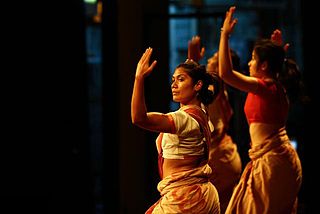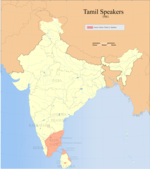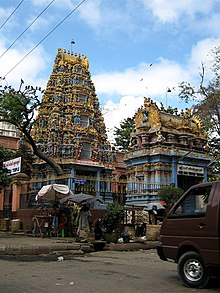
The Tamil people, also known as Tamilar, or simply Tamils, are a Dravidian ethno-linguistic group who trace their ancestry mainly to India’s southern state of Tamil Nadu, the union territory of Puducherry, and to Sri Lanka. People who speak Tamil and are born in Tamil clans are considered Tamils. Tamils constitute 5.9% of the population in India, 15% in Sri Lanka, 7% in Malaysia, and 5% in Singapore.

Hinduism in Southeast Asia had a profound impact on the region's cultural development and its history. As the Indic scripts were introduced from India, people of Southeast Asia entered the historical period by producing their earliest inscriptions around the 1st to 5th century CE. Today, Hindus in Southeast Asia are mainly Overseas Indians and Balinese. There are also Javanese and Balamon Cham minority in Cambodia and south central Vietnam who also practice Hinduism.

Hinduism is a third largest religion in Australia consisting of more than 684,002 followers, making up 2.7% of the population as of the 2021 census. Hinduism is the fastest growing religion in Australia mostly through immigration. Hinduism is also one of the most youthful religions in Australia, with 34% and 66% of Hindus being under the age of 14 and 34 respectively.

Indian Singaporeans are Singaporeans of Indian or of general South Asian ancestry. They constitute approximately 9.0% of the country's citizens, making them the third largest ancestry and ethnic group in Singapore.

Hinduism is practised by 1.7% of the population of Myanmar. Hinduism is practised by about 890,000 people in Myanmar, and has been influenced by elements of Buddhism, with many Hindu temples in Myanmar housing statues of the Buddha. There are also a large population of Hindus in which the Myanmar Tamils and minority Bengali Hindus having the biggest population share.

Burmese Indians are a group of people of Indian origin who live in Myanmar (Burma). The term 'Burmese Indian' refers to a broad range of people from South Asia, most notably from present-day countries such as India, Bangladesh and also Pakistan. While Indians have lived in Burma for many centuries, most of the ancestors of the current Burmese Indian community emigrated to Burma from the start of British rule in the mid-19th century to the separation of British Burma from British India in 1937. During colonial times, ethnic Indians formed the backbone of the government and economy serving as soldiers, civil servants, merchants, moneylenders, mobile laborers and dock workers. A series of anti-Indian riots in the 1930s and mass emigration at the onset of the Japanese invasion of Burma in 1942 were followed in the 1960s by the forced migration of hundreds of thousands of ethnic Indians, exacerbated by internal conflict in Myanmar.

The Tamil diaspora refers to descendants of the Tamil immigrants who emigrated from their native lands in the southern Indian subcontinent to other parts of the world. They are found primarily in Malaysia, Arab states of the Persian Gulf, South Africa, North America, Western Europe, and Singapore.
Racism in Asia has roots in events that have happened from thousands of years ago to the present.
Anti-Indian sentiment, also known as Indophobia or anti-Indianism, is a modern term referring to negative feelings, fear and hatred towards the Republic of India, Indian people, and Indian culture. Indophobia is formally defined in the context of anti-Indian prejudice as "a tendency to react negatively towards people of Indian extraction, against aspects of Indian culture and normative habits". Its opposite is Indomania.

The Sri Lankan Tamil diaspora refers to the global diaspora of Sri Lankan Tamil origin. It can be said to be a subset of the larger Sri Lankan and Tamil diaspora.
Chindian (Hindi: चीनी-भारतीय; Chinese: 中印人; pinyin: Zhōngyìnrén; Cantonese Yale: Jūngyanyàn; Tamil: சிந்தியன்; Telugu: చిండియన్స్; is an informal term used to refer to a person of mixed Chinese and Indian ancestry; i.e. from any of the host of ethnic groups native to modern China and India. There are a considerable number of Chindians in Malaysia and Singapore. In Maritime Southeast Asia, people of Chinese and Indian origin immigrated in large numbers during the 19th and 20th centuries. There are also a sizeable number living in Hong Kong and smaller numbers in other countries with large overseas Chinese and Indian diaspora, such as Jamaica, Trinidad and Tobago, Suriname and Guyana in the Caribbean, as well as in Indonesia, the Philippines, the United States, Canada, United Kingdom, Australia, and New Zealand.

British Indians are citizens of the United Kingdom (UK) whose ancestral roots are from India. This includes people born in the UK who are of Indian origin as well as Indians who have migrated to the UK. Currently, the British Indian population exceeds 1.8 million people in the UK, making them the single largest visible ethnic minority population in the country. They make up the largest subgroup of British Asians and are one of the largest Indian communities in the Indian diaspora, mainly due to the Indian–British relations. The British Indian community is the sixth largest in the Indian diaspora, behind the Indian communities in the United States, Saudi Arabia, the United Arab Emirates, Malaysia and Nepal. The majority of British Indians are of Punjabi, Gujarati, Bengali and Malayali descent, with smaller Tamil, Telugu, Konkani, and Marathi communities.

Tamil Malaysians, also known as Malaysian Tamilar, are people of full or partial Tamil descent who were born in or immigrated to Malaysia from Tamil Nadu, India and the Tamil regions of north-east Sri Lanka. The majority of 1.8–2 million people 80% of the Malaysian Indian populations in Malaysia were from Indian Tamil ethnic groups from Tamil Nadu and Sri Lanka. The bulk of Tamil Malaysian migration began during the British Raj, when Britain facilitated the migration of Indian workers to work in plantations. There are, however, some established Tamil communities from before British colonialism.
Karnataka is a state in the southern part of India. It was created on 1 November 1956, with the passing of the States Reorganisation Act. Karnataka is bordered by the Arabian Sea to the west, Goa to the north-west, Maharashtra to the north, Telangana and Andhra Pradesh to the east, Tamil Nadu to the south-east, and Kerala to the south-west. The state covers an area of 74,122 sq mi (191,976 km2), or 5.83% of the total geographical area of India. It comprises 30 districts. Kannada is the official language of Karnataka and as per the 2011 census is the mother tongue of 66.5% of the population. Various ethnic groups with origins in other parts of India have unique customs and use languages at home other than Kannada, adding to the cultural diversity of the state. Significant linguistic minorities in the state in 2011 included speakers of Urdu (10.8%), Telugu (5.8%), Tamil (3.5%), Marathi (3.4%), Hindi (3.2%), Tulu (2.6%), Konkani (1.3%) and Malayalam (1.3%).

Overseas Indians, officially Non-Resident Indians (NRIs) and People of Indian Origin (PIOs) are Indians who reside or originate outside of India. According to the Government of India, Non-Resident Indians are citizens of India who currently are not living in India, while the term People of Indian Origin refers to people of Indian birth or ancestry who are citizens of countries other than India. Overseas Citizenship of India (OCI) is given to People of Indian Origin and to persons who are not People of Indian Origin but married to People of Indian Origin. Persons with OCI status are known as Overseas Citizens of India (OCIs). The OCI status is a permanent visa for visiting India with a foreign passport.
Malaysia is a multi-ethnic country, with a predominantly Muslim population. Racial discrimination is embodied within the social and economic policies of the Malaysian government, favouring the Malays and in principle, the natives of Sabah and Sarawak. However, in practice, the natives of Sabah and Sarawak do not benefit much from these policies, with natives of Sabah and Sarawak composing the bulk of bottom 40% income cohort of Malaysia. Rather, it is the Malays that obtain heavily subsidised education in local universities and make up the bulk of these universities, including in terms of employment. In fact, the resources of Sarawak have been exploited for decades, with the Malaysian government enriching governmental officials and their associates. The concept of Ketuanan Melayu or Malay supremacy is accepted by the Malay-majority political sphere.

Malaysian Indians or Indian Malaysians are Malaysian citizens of Indian or South Asian ancestry. They now form the third-largest group in Malaysia, after the Malays and the Chinese. Most are descendants of those who migrated from India to British Malaya from the early 19th to the mid-20th centuries.
The Burmese community in India consists of refugees, immigrants and expatriates from Burma as well as Indian citizens of Burmese ancestry. The 2014 Myanmar Census enumerated 17,975 Burmese individuals living in India.

Penangite Indians, also known as Chulias, are Malaysian Indians that live primarily in the state of Penang, Malaysia. Most are the descendants from those who migrated from India during the British colonisation of Malaya. However, historical sources prove that the ancient Indians arrived in Penang during the Chola dynasty. Penangite Indians forms a large percentage of the state's professional community such as business, law and medicine as well as politics, it can be proven by the appointment of Dr. P. Ramasamy as deputy chief minister of Penang. It made him the first Malaysian of Indian origin to hold the post of deputy chief minister in any state of Malaysia. In addition, first Tamil Vernacular School in Malaysia was established in Penang.

Malaysian Malayalees, also known as Malayalee Malaysians, are people of Malayali descent who were born in or immigrated to Malaysia from the Malayalam speaking regions of Kerala. They are the second largest Indian ethnic group, making up approximately 15% of the Malaysian Indian population. The bulk of Malaysian Malayali migration began during the British Raj, when the British facilitated the migration of Indian workers to work in plantations, but unlike the majority Tamils, the vast majority of the Malayalis were recruited as supervisors in the oil palm estates that followed the kangani system, and some were into trading and small businesses with a significant proportion of them running groceries or restaurants. Over 90% of the Malayalee population in Malaysia are Malaysian citizens.















